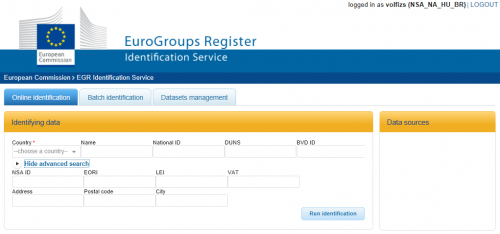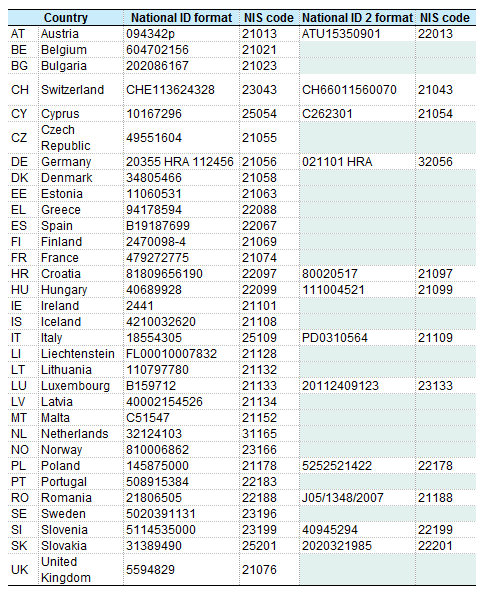EuroGroups register identification service
The EuroGroups Register Identification Service is one element of the EuroGroups register (EGR). It allows users to identify legal units and assigns unique identification numbers to these units. The EGR Identification Service aims to cover all incorporated legal units that may potentially be part of multinational enterprise groups.
Full article
The legal entity identifier number (LEID number)
The legal entity identifier number (LEID number) is the unique identification number assigned by the EGR Identification Service. The structure of LEID numbers has been created by Eurostat specifically for the purposes of the EGR; an LEID number is a combination of the country code, register code and national identification number of the legal units.
The unique identification of legal units is critical for avoiding duplications in the EGR. Any national statistical authority involved in exchanging data with the EGR must use the unique identification numbers when communicating with the EGR. For instance, when Member States’ national statistical authorities inform the EGR of relationships between resident and foreign legal units, both units should be identified with LEID numbers. Proper identification of foreign legal units will be an important step towards achieving interoperability of the national registers.
Format of the LEID number
For EU and EFTA countries the LEID numbers are composed of the two-letter country code, the internal register code assigned to the national register by the EGR (referred to as the national identification system code or NIS code) and the legal unit’s national identification (national ID) number, as assigned by this same national register.
The types of national ID number used in the EGR were chosen by the Member States’ national statistical authorities. The aim was to select types of ID numbers that are also widely available from commercial sources in order to simplify the matching to be carried out in the EGR process. Several Member States specified secondary national ID numbers that are stored in additional national registers. They are not used for the creation of the LEID number but can be important for linking the records held by the EGR Identification Service to the records acquired from commercial data sources.
For extra-EU and EFTA countries the LEID numbers are composed of the two-letter country code and an 11-digit sequential number.
Examples for the LEID number
The LEID number generated by the EGR for legal units based in Austria is a combination of the country code ‘AT’, the Austrian trade register’s internal register code ‘21013’ and the identification number given to a particular legal unit within this register, e.g. ‘094342p’. The LEID number for this legal unit would therefore be ‘AT21013094342p’.
The LEID number generated by the EGR for legal units based in Belgium is a combination of the country code ‘BE’, the Belgian business register’s internal register code ‘21021’ and the identification number given to a particular legal unit within this register, e.g. ‘0604702156’. The LEID number for this legal unit would therefore be ‘BE210210604702156’.
Sources and updating of the EGR Identification Service
The EGR Identification Service uses a database for searching, matching and identifying the legal units. The database is maintained with data of the national statistical authorities of the EU and EFTA countries. Commercial data providers are the EGR Identification Service’s only source of information on legal units outside the EU and EFTA countries, as the national statistical authorities’ business registers only contain information on domestic legal units. The EGR Identification Service database is updated once per year.
Functionalities of the EGR Identification Service
The EGR Identification Service provides a means of retrieving identification information relating to legal units. The LEID number is the unique identification number assigned to legal units. In addition to the LEID number, the EGR Identification Service also contains other information serving to identify a particular legal unit, e.g. the name and address of the unit and/or additional ID numbers. Users can search for legal units using any of these pieces of ‘identifying information’ and can then download the full file of information relating to that unit into their national statistical business registers.
Manual identification of legal units
The online interface of the EGR Identification Service allows users to search for one specific legal unit. To carry out a manual search, the user must enter the country in which the legal unit is based, and can then add additional search criteria such as the company name, the city in which it is based, its address, its national ID number, commercial ID number(s) or other ID number(s) (e.g. VAT number). At least one of the company name, the national ID number and the commercial ID number should be entered when performing a search.
Batch identification of legal units
Where users need to identify a set of legal units, they can send files containing the search criteria to Eurostat via the eDAMIS secure communication platform. The minimum required search criteria when using this method are the country code and the name of the legal unit. The user can also include any other available information (e.g. the city in which the unit is based, its address, its national ID number, commercial ID numbers or other ID numbers), in order to make the search more efficient.
Search mechanism applied in the identification process
Where searches are performed using ID numbers, e.g. national or commercial ID numbers, the EGR Identification Service will produce either one single result or no results. Where a search has multiple results, e.g. a search based on a name, the system may display up to 20 possible matches, sorted in descending order, on the basis of how well they match the search criteria. It is only when a search is performed using text, that the system computes the closeness of each match.
The EGR Identification Service computes the closeness of the match on the basis of the Levenshtein distance algorithm. For each of the criteria provided, the distance between the criterion value (i.e. the term entered in the search) and the entry in the corresponding field of the record suggested as a possible match is computed. A weighted average is then taken of the ‘similarity score’ for each criterion. This is shown as this result’s ‘final score’ on the search results panel.
The criteria used in the full text search have the following weights: name of the legal unit: 4; country code: 1 (the country code must match exactly); address: 1; postcode: 1; city: 1. Where the data for the address, postcode or city is missing or has a low ‘similarity score’, the system will not take these fields into account in calculating the weighted average.
LEID search criteria
The EGR Identification Service uses configuration of predefined search criteria to determine the way of searching for LEID numbers in the database.
To update files on resident legal units provided by national statistical authorities, the search is only executed on the combination of country code, national ID number and its register code.
Searches performed for the purpose of identifying files on non-resident legal units provided by national statistical authorities the search is executed on multiple variables in the following order:
- search on combination of country code, national ID number and its register code;
- search on commercial ID numbers;
- search on the combination of country code, company name, city, postcode and address details;
- search on the combination of country code and company name.
For files from commercial data providers, the search is executed on multiple variables in the following order:
- search on commercial ID numbers;
- search on the combination of country code and national ID number;
- search on the combination of country code, company name, city, postal code and address details;
- search on the combination of country code and company name.
Access to the EGR Identification Service
Access to the EGR Identification Service is restricted to users at national statistical institutes of the EU and EFTA countries.
Users need to have an account and a password in order to access the system. Users can apply for an account via the EGR contact persons in the national statistical institutes.
Direct access to
- Methodology on enterprise groups and registers is available in the Business registers Recommendations manual
- EuroGroups Register metadata EGR 2018 Metadata Report
Current legislation
- Implementing Regulation (EU) 2020/1197 of 30 July 2020 laying down technical specifications and arrangements pursuant to Regulation (EU) 2019/2152 of the European Parliament and of the Council on European business statistics repealing 10 legal acts in the field of business statistics
- Regulation (EU) 2019/2152 of the European Parliament and of the Council of 27 November 2019 on European business statistics, repealing 10 legal acts in the field of business statistics
Repealed legislation
- Regulation (EC) No 177/2008 of 20 February 2008 establishing a common framework for business registers for statistical purposes (Summary)
- Regulation (EC) No 192/2009 of 11 March 2009 implementing Regulation (EC) No 177/2008, as regards the exchange of confidential data between the Commission (Eurostat) and Member States
- Regulation (EC) No 1097/2010 of 26 November 2010 implementing Regulation (EC) No 177/2008, as regards the exchange of confidential data between the Commission (Eurostat) and central banks

